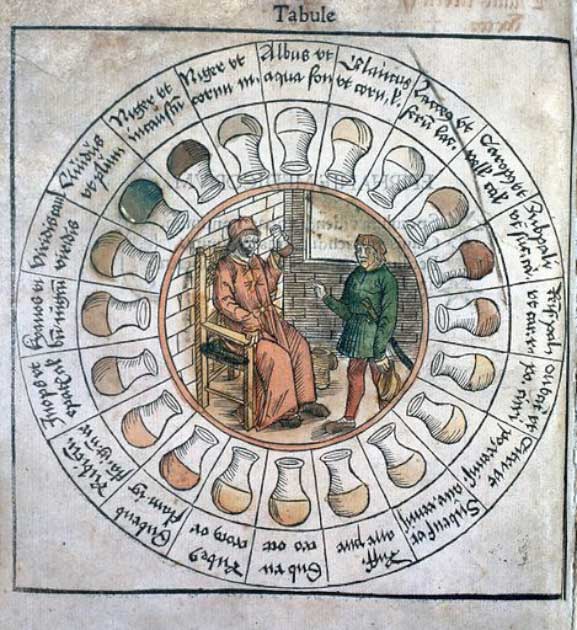[ad_1]
The examination of urine (‘uroscopy’) as a method of medical diagnosis can be traced back to ancient Greece and Rome, but during the Middle Ages the examination of urine samples by physicians became widespread. Not only did doctors note the differences in color and consistency, they also used to taste and smell their patient’s pee!
During the Middle Ages, it was considered socially unacceptable to directly examine a patient, or even to disrobe him or her. Therefore, observing a person’s urine was a discrete method of diagnosing a patient’s illness.
Urology was greatly aided during this period by the development of the urine wheel. In essence, this was a chart (in the form of a wheel) which helped the medieval physician in his diagnosis of a patient’s illness.
The urine wheel is divided into 20 different parts, each of which shows a different color of urine. In addition to observing the urine, medieval doctors also relied on their sense of taste and smell, as the taste and smell of a patient’s urine were affected by the illness they were suffering from, and generally corresponded with specific colors.

Urine chart for diagnosis, 1506 AD. ( Wellcome Collection / CC BY-SA 4.0 )
The variations of urine smells and tastes were also described in the urine wheel. As an example, the 17th century English physician Thomas Willis noted that the urine of a diabetic patient tasted “wonderfully sweet as if it were imbued with honey or sugar.” It was Willis who coined the term ‘mellitus’ (meaning ‘sweetened with honey’) in diabetes mellitus, and this disorder was once known as ‘Willis’s disease’.
Uroscopy and the urine wheel continued to be used up by European physicians to diagnose their patients, regardless of social status, up until the middle of the 19th century. The urine of King George III of England, for instance, is reported to have been purple in color, and it may have been a sign that he was suffering from porphyria, which is a group of diseases that negatively affected the nervous system. It has been speculated that this could have caused the madness that the king was infamous for.
Towards the end of the 19th century, chemical analysis began to be used for the examination of urine. In consequence, uroscopy and the urine wheel fell out of favor, and doctors no longer needed to taste their patients’ wee!
Read more: The Urine Wheel and Uroscopy: What Your Wee Could Tell a Medieval Doctor
Top image: The Medical Alchemist vt. The Uroscopy by Franz Christoph Janneck (1703–1761), ( Science History Institute )
By Wu Mingren
[ad_2]
Source link
